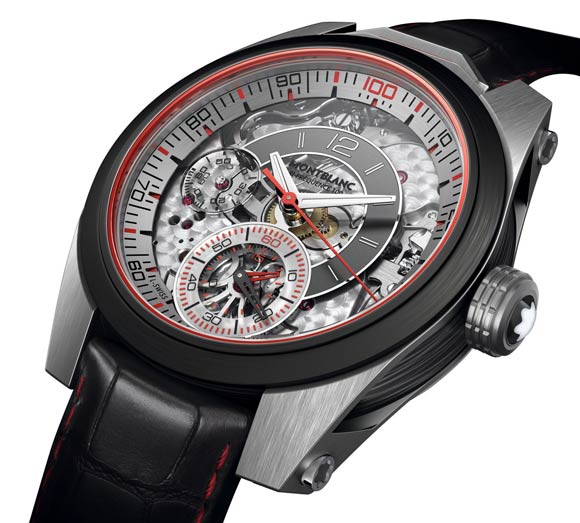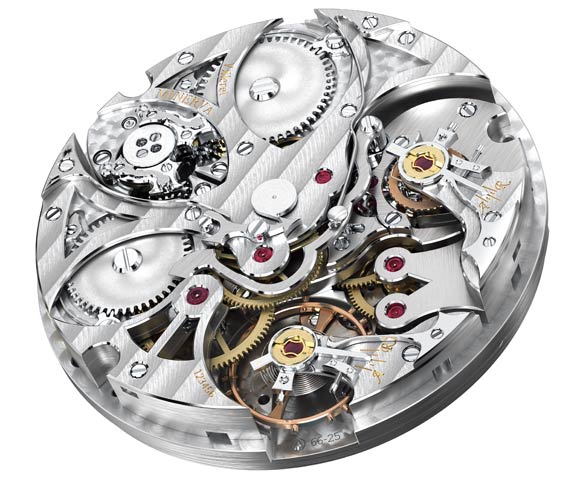A patented chronograph function enables the Montblanc TimeWalker Chronograph 100 to perform a feat that’s seldom achieved by mechanical timepieces: it can measure elapsed intervals to the nearest 100th of a second. To accomplish this, the watch relies on the Montblanc Manufacture’s nearly century-old competence for measuring intervals to the nearest 100th of a second. The Minerva Manufacture, which would later become the Montblanc Manufacture in Villeret, launched its first mechanical 100th-of-a-second stopwatch in 1916. Subsequent versions were equipped with a chronograph hand that requires just one second to complete a full 360° circuit of the dial. Precisely this principle is employed by the Montblanc TimeWalker Chronograph 100 with its newly developed manufacture calibre MB M66.25.
This high-performance manufacture calibre is embedded in a case crafted from materials which are used in racing cars.

One Movement – Two Hearts
For a watch to measure intervals with 100th-of-a-second precision, its balance must be able to vibrate at a frequency of 360,000 semi-oscillations per hour (50 hertz). In conventional chronograph wristwatches, one and the same balance drives both the ordinary time display and the chronograph mechanism for measuring elapsed intervals. Activating the “start” function creates a connection between the going train and the chronograph; this link is severed when the “stop” function is triggered.
Due to its need for a frequency of 360,000 semi-oscillations per hour, the Montblanc TimeWalker Chronograph 100 cannot rely on the same mechanical principle as a conventional chronograph calibre, which vibrates at a much slower pace of 2.5 or 4 hertz. This necessity prompted the watchmakers in Villeret to devise a solution with two balances. A large, massy, screw balance oscillates at a frequency of 18,000 A/h (2.5 Hz) to ensure the precise rate of the going train, while a small balance paced at the extremely high frequency of 360,000 A/h (50 Hz) regulates the chronograph function.
Rather than remaining continually in motion, the separate balance for the chronograph begins to vibrate only when the “start” function is activated by a flexible steel lamella (called fouet) mounted behind the arrowhead of the chronograph rocker. When the “stop” function is triggered, this slender steel plate arrests the tiny 50-Hz balance and holds it motionlessly in place until the next elapsed-time measurement begins.
The chronograph function is powered by its own barrel, which stores enough energy to measure intervals up to 45 minutes in duration. An elapsed-time measurement can be indefinitely extended by turning the crown anticlockwise while the chronograph is running, thus adding fresh energy to the chronograph’s barrel. The going train for the ordinary time display draws its energy from a second barrel that guarantees a 100-hour power reserve.

The Chronograph’s Patented Control Mechanism
The TimeWalker Chronograph 100 is equipped with two zero-return mechanisms: one for the 100ths of a second and another for the elapsed minutes and seconds. The engineers at the Montblanc Manufacture in Villeret devised a patented mechanism with an innovative column-wheel control and a novel zero-return solution for the central 100ths-of-a-second hand or trotteuse. A two-level column-wheel separates the functional level for starting and stopping the chronograph from the zero-return level for the elapsed-time counters. The column-wheel bears four narrow and four broad pillars, between which alternately higher and lower switching levels are positioned. The higher level controls the chronograph rocker: its arrowhead carries the slender steel lamella that starts and stops the finely toothed 50-Hz balance.
When the measurement of an elapsing interval commences, the column-wheel gives an impulse to the chronograph rocker, which then moves away from the high-frequency balance and transfers the impulse via the steel lamella (fouet) at its tip to the balance, which instantly begins vibrating at an hourly frequency of 360,000 semi-oscillations.
When the measurement of the elapsed interval is halted, the column-wheel moves the chronograph rocker toward the chronograph’s balance so that the steel lamella presses against the balance’s rim, thus halting both the balance’s vibrations and the progress of the chronograph’s elapsed-time hands.
The lower level of the column-wheel is the switching plane for the beak of the heart-lever. This lever returns to zero the 60 elapsed-seconds hand, which is connected to the heart-lever of the 15 elapsed-minutes counter. Heart-levers and heart-cams act in the conventional manner to return these two counters to their zero positions.
By contrast, the zero-return of the 100th-of-a-second hand is accomplished in an innovative way. The 100thof- a-second wheel carries a disc with a catch. While an ongoing interval is being measured, the heart-lever of the seconds-counter wheel presses a little arrowhead-shaped lever with a barb away from this catch. When the chronograph’s hands are returned to their zero settings after the duration of an elapsed interval has been measured, the heart-level releases the little lever; a spring now presses the lever against the wheel with the catch. The 100th-of-a-second hand is freed to complete its unfinished circuit until it reaches its zero position, where it is halted because the catch of its zero-return disc engages with the barb of the zero-return lever.

Traditionally Fabricated Movements
The design and construction of the movement are innovative, but the manufacturing methods rigorously uphold horological tradition. The Montblanc Manufacture in Villeret is one of the few remaining manufactories where all of these time-honoured skills are still practiced. Plates, bridges and steel components are manually fabricated and decorated with circular graining and/or Geneva waves. Edges are manually bevelled; the bevels are then polished by hand and the flanks undergo brushfinishing.
Each balance-spring is individually counted by hand and by the artisan’s unaided eyes. Meticulous handcraftsmanship is likewise used for the mise en fonction of the chronograph: here, the functional surfaces of all rockers and levers are abraded to match each other with tolerances in the 100th-of-a-millimeter range, and the ruby pallet-stones are exactly adjusted in the pallets.
The Case is made of High-Tech Materials
The tripartite case combines various high-tech materials. The titanium steel bezel is coated with a layer of extremely scratch-resistant DLC (diamond-like carbon). The screwed back is crafted from titanium and bears an inset pane of sapphire crystal. Titanium sheathed with carbon fibre forms the middle piece of the case: Montblanc crafts this sheath as a seamless, complexly structured cocoon rather than merely gluing a simple carbonfibre shell around the titanium carrure. Several dozen layers of carbon fibre, with the fibres in each layer oriented at 90° to those in the preceding stratum, are fused together with artificial resin at high temperature with a pressure of 10 tons. This produces a compact carbon-fibre block.
The case’s round sheath is stamped perpendicularly to the carbon-fibre layers to form a seamless “monoblock” which is then tautly stretched over the case’s titanium middle piece. The monoblock’s surface boasts a special horizontally striped pattern rather than the typically uniform texture of carbon-fibre. This intimate liaison between titanium and ageingresistant carbon fibre results in a lightweight yet remarkably robust case that optimally protects its precious mechanical inner life. The middle piece of the case is clamped between two pierced longitudinal titanium brackets. These transition into the characteristic skeletonised horns of the TimeWalker collection and give the case its distinctive TimeWalker look.
The large crown is likewise crafted from titanium and topped by an inset Montblanc emblem made of mother-of-pearl. Nonslip crosswise fluting around the crown’s flanks facilitates manual winding, which can be performed in two directions: turning the crown clockwise tightens the mainspring for the going train, turning it anticlockwise provides energy for the chronograph function. As a reference to the stopwatch that Minerva launched in 1916, the chronograph button on the Montblanc TimeWalker Chronograph 100 is similarly positioned at “12 o’clock”.
The horizontally satin-finished flange along the dial’s circumference is calibrated with a 100thsof- a-second scale and printed with a red “100” at “12 o’clock”. The dial is fabricated from transparent sapphire crystal and offers an unobstructed view of newly developed manufactory Calibre MB M66.25. An especially interesting detail here is the column wheel with its wolf’s teeth at “12 o’clock” which advances by one increment each time the chronograph pusher is triggered; as well as the components of the bidirectional winding mechanism at 3 o`clock.
The ordinary time of day or night is displayed on an anthracite-grey hour-scale framed in silver. This scale is interrupted by a disc of sapphire crystal printed with a scale for the continually running seconds at “9 o’clock” and by the chronograph’s counter for 60 elapsed seconds and 15 elapsed minutes at “6 o’clock”.
Like the hands on all TimeWalker chronographs, the hour-hand and minute-hand are lanceolate and inlaid with strongly luminous Superluminova.
The significance of the chronograph function is clearly understandable when one scrutinizes the 100ths of- a-second scale and the counters for 60 elapsed seconds and 15 elapsed minutes. The large trotteuse, which is made of lightweight aluminium is coated with red lacquer; it completes one rotation per second to precisely indicate the measured time to the nearest 100th of a second. The counter at “6 o’clock” is a transparent disc of sapphire crystal marked with two concentric scales, each of which is swept by its own skeletonised lanceolate hand: the longer black hand progresses along the outer scale, which is marked with Arabic numerals for 60 elapsed seconds; the shorter red hand slowly advances along the inner scale, which is calibrated for 15 elapsed minutes.

The screwed titanium back bears a scratch-resistant pane of sapphire crystal, through which the movement’s complexity and decorations are visible.
The new wristwatch is affixed to a strap made of black alligator-leather with large reptilian scales. Contrastingly coloured red stitching and a titanium pronged buckle complete the wristband.
The Montblanc TimeWalker Chronograph 100 will become available starting in the autumn of 2014. It will be produced in a strictly limited series of 100 timepieces, each of which will sell for a retail price of € 50,000.




